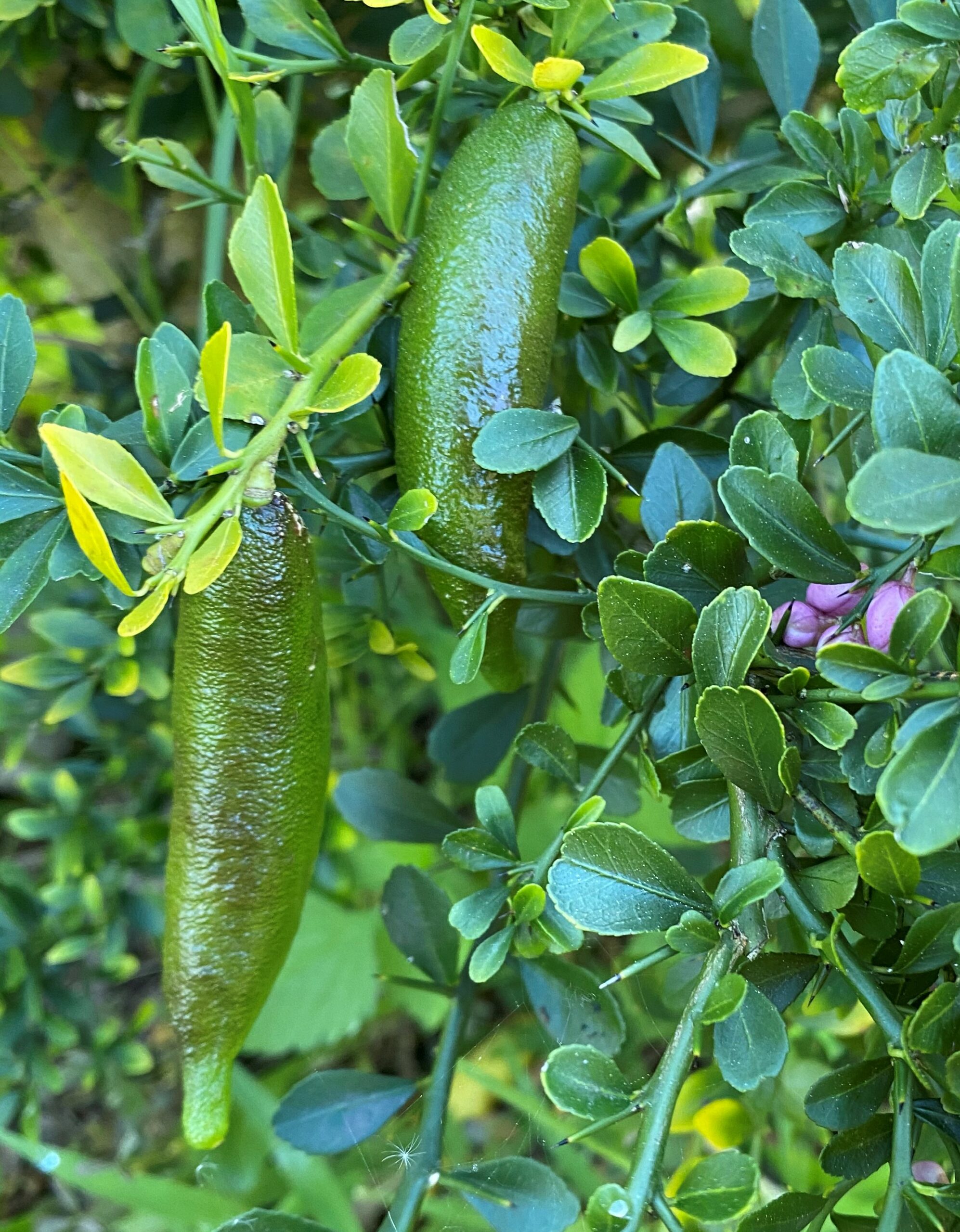
Citrus Australasica
Common name: Fingerlime
· Tolerates light frost
· Full sun, half shade
· Small tree/ large shrub, height 3-6m, width up to 3m
· Well-drained, loamy, sandy soils
· Fruiting 2-3 years from cuttings, 8 years from seed
· Edible fruit
· Attracts – bees, butterflies & other insects
Looks like: Large shrub to small tree up to 6 m tall, with spines up to 25mm long. The leaves have many aromatic oil glands. Flowers are commonly white, but can also be pale pink. The elongated cylindrical fruits may be green, yellow, black, brown or purple producing flesh that is green, yellow or pink. The fruit has a high commercial value because of its distinctive caviar appearance and tangy taste, making it a desirable species of Citrus to grow. There are currently 5 registered finger lime cultivars including Citrus australasica ‘Alstonville’, Citrus australasica ‘Blunobia Pink Crystal’, Citrus australasica ‘Durhams Emerald, Citrus australasica ‘Judy’s Everbearing’ and Citrus australasica ‘Pink Ice’.
Habitat & Growing: Belongs to the Rutaceae family, which includes all forms of citrus fruits. It occurs along the east coast of Australia, ranging mainly from south east Queensland to north-east New South Wales in tropical to subtropical rainforest communities.Can be grown on a wide range of soils in tropical and subtropical rainforest communities. In temperate areas, deep loamy soils with adequate irrigation are ideal. Soil should be nutrient rich, with high levels of organic matter with slightly acidic soil. It is able to withstand light frost levels. In cooler climates, a semi shaded area in a north facing site is preferred. Mulch during spring and have a good water regime to keep soil moist during summer and lightly prune annually after fruiting in autumn. No fertiliser is required for maintenance.
It is possible to be grown from seed, cuttings or grafting onto exotic citrus species. C. australasica is slow growing, and if grown from seed it may take up to 15 years to reach maturity. It is essential that the seed used is as fresh as possible to maximize success rates. Semi-hardwood cuttings, like seedlings, have a very slow growth rate and low success rate. Root hormone is required when growing C. australasica from a cutting to help development. Ideally cuttings and seedlings should be grown in 100 litre containers. When grafted onto exotic citrus, species mature faster and are able to withstand other soil and climatic conditions. The most common exotic species they are grafted to are Citrus trifoliata and Troyer citrange.
Citrus australasica flowers late autumn to summer, with the fruit ripening between May and June.
Due to undesirable climatic conditions, the flowering and fruiting ability is significantly decreased in areas south of Sydney. A number of pests including aphids, caterpillars, grasshoppers affect C. australasica. The fungal disease Melanose (Diaporthe citri), oleocellosis, where oil is released from damaged oil glands, and environmental damage from the wind and sun are also problems that may be encountered.
| Family | Rutaceae |
| Plant Type | Small tree, Large shrub |
| Width | 5 |
| Flowering Time | Spring |
| Soil Type | Loamy, Sandy loam, Clay loam |
| Climate Zone | Sub-tropical, Warm temperate, Cool temperate, Mediterranean |
| Growth Habit | Evergreen, Spreading |
| Soil Moisture | Well-drained |
| Special Uses | Edible, Decorative fruit, Erosion control, Bird nesting plant |
| Height | 7 |
| Flower Colour | White |
| pH Level | Acid, Neutral |
| Plant Environment | Container growing |
| Light | Sunny, Light shade |
| Lifespan | Perennial |
| Frost Tolerance | Tolerates light frost |
| Attracts Wildlife | Bees, Butterflies, Other insects |
Distribution:

Traditional uses: The fruit was eaten for its delicious taste and its ability to ward off disease. The pulp and juice of Finger Limes were also applied as an antiseptic to infected sores and boils. Bursting with zesty flavour, Finger Limes are rich in folate, potassium and Vitamin C, E.

